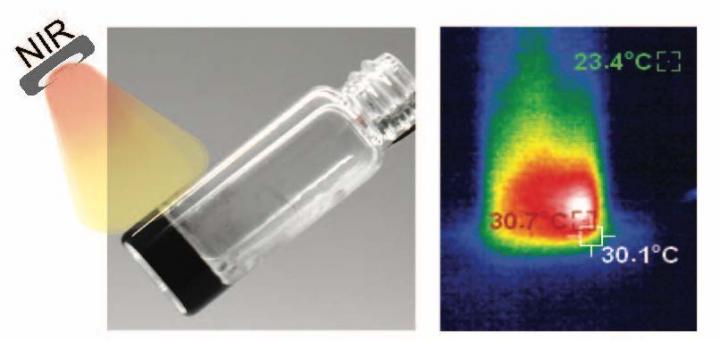Lighting Hydrogels Via Nanomaterials

This visual representation demonstrates how light?responsive hydrogels absorb and convert near-infrared light to heat, which can be developed to control thermoresponsive materials.
Credit: Dr. Akhilesh Gaharwar/Texas A&M Engineering
Texas A&M associate professor Akhilesh Gaharwar and graduate student Patrick Lee are developing a new class of hydrogels that can leverage light for drug delivery and regenerative medicine treatments.
Hydrogels are commonly used inside the body to help in tissue regeneration and drug delivery. However, once inside, they can be challenging to control for optimal use. A team of researchers in the Department of Biomedical Engineering at Texas A&M University is developing a new way to manipulate the gel — by using light.
Graduate student Patrick Lee and Dr. Akhilesh Gaharwar, associate professor, are developing a new class of hydrogels that can leverage light in a multitude of ways. Light is a particularly attractive source of energy as it can be confined to a predefined area as well as be finetuned by the time or intensity of light exposure. Their work was recently published in the journal Advanced Materials.
Light?responsive hydrogels are an emerging class of materials used for developing noninvasive, noncontact, precise and controllable medical devices in a wide range of biomedical applications, including photothermal therapy, photodynamic therapy, drug delivery and regenerative medicine.
Lee said light-responsive biomaterials are often used in biomedical applications; however, current light sources, such as ultraviolet light and visible light, cannot sufficiently penetrate the tissue to interact with the hydrogel. Instead, the team is researching near-infrared (NIR) light, which has a higher penetration depth.
The team is using a new class of two-dimensional nanomaterials known as molybdenum disulfide (MoS2), which has shown negligible toxicity to cells and superior NIR absorption. These nanosheets with high photothermal conversion efficiency can absorb and convert NIR light to heat, which can be developed to control thermoresponsive materials.
In the group’s previous study published in Advanced Materials, certain polymers react with MoS2 nanosheets to form hydrogels. Building on this discovery, the team further utilizes MoS2 nanosheets and thermoresponsive polymers to control the hydrogel under NIR light by photothermal effect.
“This work leverages light to activate the dynamic polymer-nanomaterials interactions,” Gaharwar said. “Upon NIR exposure, MoS2 acts as a crosslink epicenter by connecting with multiple polymeric chains via defect?driven click chemistry, which is unique.”
NIR light allows internal formation of therapeutic hydrogels in the body for precise drug delivery. For cancer therapy, most of the drugs can be retained within the tumor, which will ease the side effects of chemotherapy. Moreover, NIR light can generate heat inside the tumors to ablate cancer cells, known as photothermal therapy. Therefore, a synergetic combination of photothermal therapy and chemotherapy has shown a higher efficacy in destroying cancer cells.
###
This study is funded by the New Innovator Award from the National Institutes of Health, as well as the Texas A&M President’s Excellence Fund through X?grant and T3.
All latest news from the category: Health and Medicine
This subject area encompasses research and studies in the field of human medicine.
Among the wide-ranging list of topics covered here are anesthesiology, anatomy, surgery, human genetics, hygiene and environmental medicine, internal medicine, neurology, pharmacology, physiology, urology and dental medicine.
Newest articles

Innovative 3D printed scaffolds offer new hope for bone healing
Researchers at the Institute for Bioengineering of Catalonia have developed novel 3D printed PLA-CaP scaffolds that promote blood vessel formation, ensuring better healing and regeneration of bone tissue. Bone is…

The surprising role of gut infection in Alzheimer’s disease
ASU- and Banner Alzheimer’s Institute-led study implicates link between a common virus and the disease, which travels from the gut to the brain and may be a target for antiviral…

Molecular gardening: New enzymes discovered for protein modification pruning
How deubiquitinases USP53 and USP54 cleave long polyubiquitin chains and how the former is linked to liver disease in children. Deubiquitinases (DUBs) are enzymes used by cells to trim protein…



